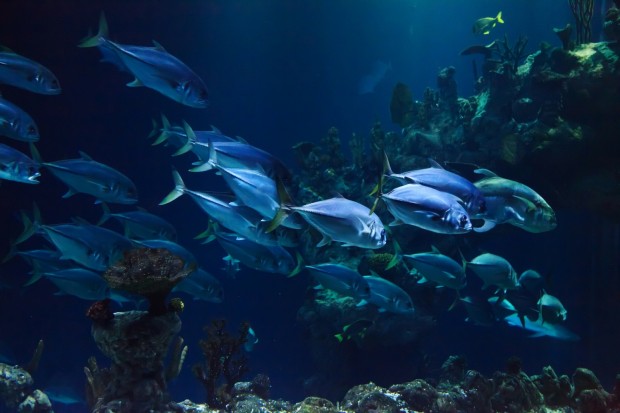Russian Arctic Researchers Say: Norilsk Fish Safe to Eat
Russian scientists have presented preliminary results of the ichthyofauna study in the vicinity of the Russian Arctic city of Norilsk, an area affected by the diesel fuel spill that happened in May last year. The findings are conclusive: the fish are safe to eat.
In St. Petersburg, the scientists presented the preliminary results of two research expeditions undertaken this year on Taimyr - the Arctic peninsula, home to one the world's northernmost cities Norilsk. Their story was told at a forum called "Arctic: Today and the Future".
Norilsk is set 300 km north of the Arctic Circle, just 2,400 km from of the North Pole. It is one of the five most northern cities in the world, with a population of around 200,000 people. The top five most northern cities also include Russia's Murmansk, Norway's Hammerferst, Alaska's Anchorage, and Rovaniemi, the capital of Finnish Lapland.
The Taimyr Peninsula is the northernmost inland part of the Eurasian continent and the largest Russian peninsula. It has an area of almost 400 thousand square km. By comparison, the area of Germany is about 360 thousand square km. Taimyr is covered with a dense water network and is dubbed the land of a thousand lakes.
All Taimyr lakes are crystal clear cold-water lakes and are rich in valuable commercial fish. They are home to salmonids: whitefish, nelma, muksun, vendace, whitefish, omul and char. Among other local fish species are burbot, grayling, pelad, smelt.
All of the northern fish are highly prized for their excellent taste. Fish and fish dishes often feature at the annual gastronomic festival in Norilsk called "The North". Local chefs cook many fish dishes using fish, one of the best treats the extreme Russia's north has to offer. Char, a salmon relative, is probably the most valuable fish here. It contains polyunsaturated omega-3 fatty acids. This fish inhabits the lakes of the Khatanga river basin and those of the Norilo-Pyasinskaya system. It could be the world's healthiest fish to eat.
Earlier this year researchers travelled to Norilsk to check in on the Taimyr fish as some had feared the fuel spill 18 months ago in Norilsk could have its toll on the Arctic lake dwellers. With a sigh of relief neither the Artur Chilingarov Polar Exploration Foundation, nor the Great Norilsk Expedition were able to find any pathological changes in the fish life of Lake Pyasino and the upper reaches of the Pyasina River.
Starting in 2020 with the Great Norilsk Expedition, this campaign saw 14 research institutes of the Russian Academy of Sciences' Siberian Branch (RAS SB) participating in the first stage of the fieldwork, and the second stage featuring 11 research institutes having taken place this year. Then an alternative expedition descended on Taimyr the Chilingarov Polar Expedition.
According to Head of the Polar Expedition Fyodor Romanenko (PhD Geography), the goal of the study was to obtain current, full and reliable information based on comprehensive expedition research. The scientists conducted a detailed and dedicated study of the current state of both the ecosystem as a whole and its components to make an unbiased assessment of the accident's repercussions (including those longterm) for the Norilo-Pyasinskaya water system biogeocenosis.
The study included both water and fish samples in the affected area. In particular, 306 samples were taken to assess the health of the fish. Other tests included water contamination and chemical and toxicological analysis, as well as sanitary, hygienic and microbiological lab surveys of the NID fishery. Fyodor Romanenko says that 108 ichthyofauna samples have been tested so far, and the results are all below the maximum permissible levels for toxic elements, salmonella, opisthorchis, and anisakis. In fact, the scientists safely subsisted on local fish during the fieldwork.
The Polar Expedition findings align with those of the Great Norilsk Expedition (its second stage of summer-autumn 2021). Nikolay Yurkevich, Director at the RAS SB Ecology Research Centre and Head of the expedition's field stage, presented his conclusions at the same working session titled "Polar Foundation's study on the NID ecosystem: unique experience and preliminary results" and held as part of the International Arctic forum.
The work scale was comparable to last year's: the fieldwork included three stages, with ichthyologists joining during the third one. The biological analysis was carried out during the fish capturing stage and included 62 samples from Lake Pyasino, 6 samples from the Ambarnaya River, and 18 samples from Lake Melkoye. (Note: the latter had not been affected by the spill; measurements needed to be taken to assess the general state of the ecosystem)
"Upon visually inspecting the scales, gills and innards (liver, kidneys, GI tract, gonads), we found no pathology - the fish are physiologically fine," said Nikolay Yurkevich. He added that by now the environmental impact of the diesel fuel spill has abated due to the ecosystem's self-regeneration properties.
That said, research by both groups of scientists is still in progress. Nonetheless, the analysis of water resources in the affected areas will continue. "Regular observations are one of the tools to address the legacy of the past and find a way to move forward," said Fyodor Romanenko.
For its part, Nornickel emphasises that it is ready to provide overarching support and funding for further studies. According to Andrey Grachev, Nornickel's Vice President for Federal and Regional Programmes, the scientific approach will underpin Nornickel's successful operations.
"We clearly understand the need to carry on with the research, not so much for our own sake, but for the sake of Russia's Arctic Zone. While science helps Nornickel gain knowledge on how to properly manage large companies and private businesses in the Arctic, our experience can be leveraged by all Russian companies operating in this fragile and unique macro region," said Grachev.
See Now: NASA's Juno Spacecraft's Rendezvous With Jupiter's Mammoth Cyclone
* This is a contributed article and this content does not necessarily represent the views of scienceworldreport.com





Join the Conversation